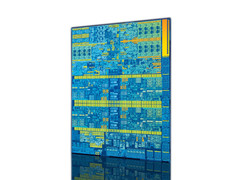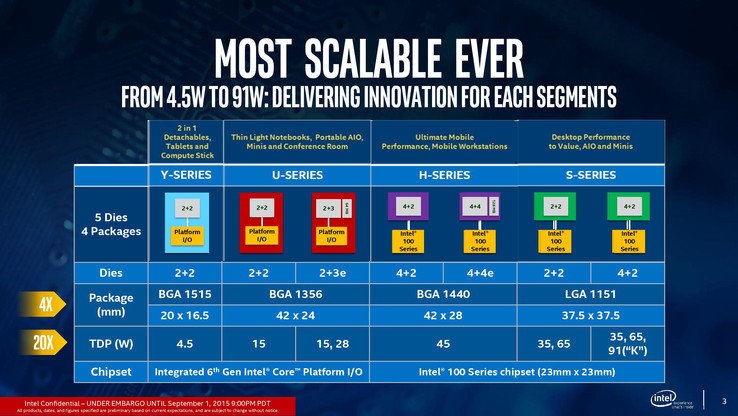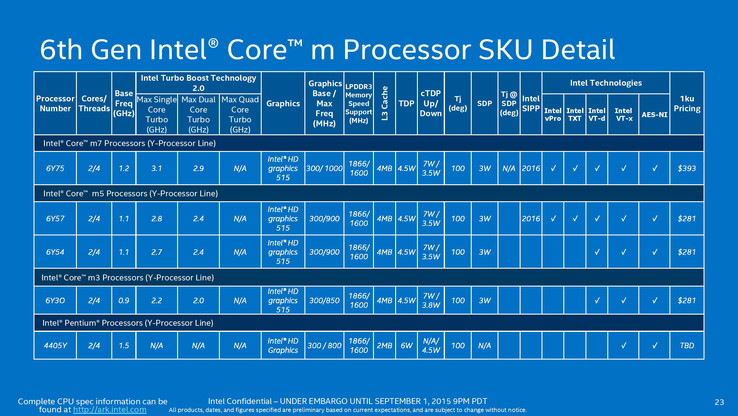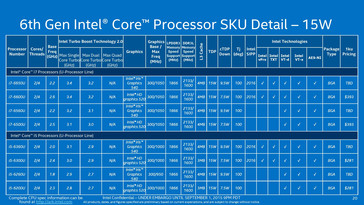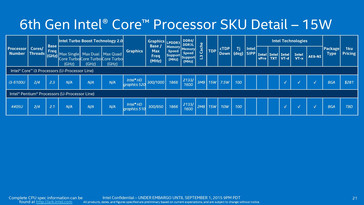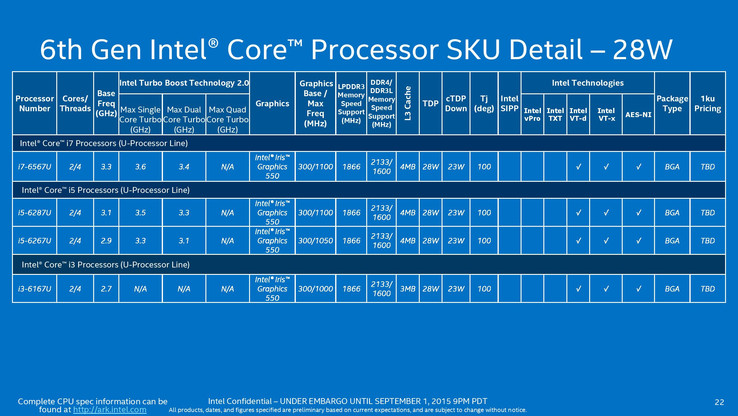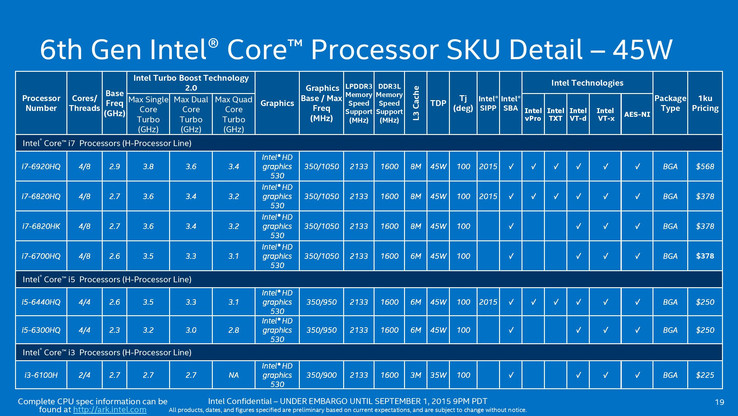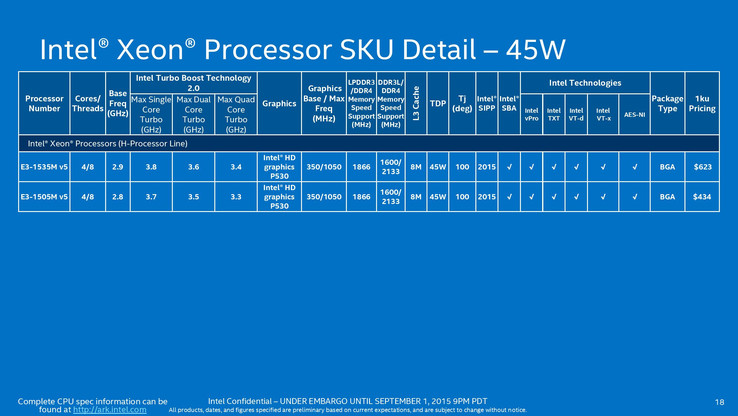Scalability, performance, and energy efficiency: These are the keywords that are central to Intel's Skylake generation. After more than 27 months since the introduction of the first Haswell models, the chip giant is launching a new microarchitecture, which is supposed to cover all market segments from ULV SoCs up to quad-core meteors of the high-end category - thus raising hopes for a significant leap in performance and features.
The manufacturer already gave a first foretaste of Skylake's capabilities in the last month with the presentation of the two desktop models, Core i7-6700K and Core i5-6600K, at the Cologne Gamescom trade fair. Due to stagnating and partly even slightly lower clock rates, the performance gain appeared to be rather small at a first glance. However, the manufacturer notably reduced power consumption. In addition, the 14 nm process appears to be especially beneficial with low clock rates. So, chances are good that the new mobile chips can make a big leap forward. Intel presented 28 of them at the time of writing, which we will look at in more detail now.
Let's first take a look at the different configurations of the Skylake die. Alike in the past, Intel distinguishes the processors according to the number of CPU cores, the level of the graphics unit and the presence of an eDRAM cache. Differences to Haswell can already be seen here: First of all, it is the first time that 64 MB eDRAM is also available in (U)LV chips of the 15 and 28 Watt classes. At least this is true for models with GT3 GPU (48 EUs). As a result, the marginal performance gain compared to GT2 models (24 EUs) should increase drastically - and could make ultrabooks without dedicated graphics cards offer acceptable gaming capabilities.
The so-called "4+4e" configuration, i.e. a quad-core die with GT4 graphics (72 EUs) and 128 MB eDRAM stands out. Thanks to it, the new top model delivers at least 50% more GPU performance than Haswell (GT3e: 40 EUs) and Broadwell (GT3e: 48 EUs). In addition, the architecture was improved and supports fast DDR4 memory. Unfortunately, such models will only be available in the coming months or in 2016.
Most of the coming Skylake notebooks might still incorporate two or four CPU cores and a GT2 graphics unit without eDRAM. Celeron and Pentium chips for the low-end segment are apparently simply partly deactivated. According to the current state of knowledge, there is no separate mask for models with GT1 graphics unit (probably 12 EUs).
We will introduce the new models of each TDP class in more detail now:
Let's start with the most frugal TDP class. The Core m chips only specify a TDP of 4.5 Watt and are internally also called Y series. Alike the Core i series, Intel divides the CPUs for (mostly passively cooled) tablets and 2-in-1 notebooks into three performance classes called m3, m5, and m7, which basically only differ by their clock rates and a few (business) features. The new top model is the Core m7-6Y75, which clocks slightly higher than the previous Core M-5Y71 top model with 1.2 to 3.1 GHz. Otherwise not much changed compared to Broadwell: We already know the key data like two CPU cores with Hyper-Threading, 24 EUs (GT2 graphics unit) and 4 MB L3 cache from the predecessor. At most, the Pentium 4405Y is noteworthy. The cheap entry-level model without Turbo Boost with only 2 MB L3 cache and a GT1 graphics closes the gap to the Cherry Trail SoCs in the low-end segment.
By far the largest part of the new Skylake processors belongs to the 15 Watt class, which is not only used in most ultrabooks, but also in many slim laptops with display diagonals between 11 and 17-inches. On average, the various models clock about 100 MHz higher than their respective Broadwell predecessors. However, the more important novelty is the already mentioned GT3e models with 64 MB eDRAM cache. The expected performance boost is apparent in the GPU names: While the GT2 version is marketed as HD Graphics 520, the GT3e is called Iris Graphics 540. The prefix "Iris" was previously reserved for the fastest Intel GPUs.
In addition, we want to emphasize the enhancement of the Pentium series with Hyper-Threading (an improvement that had been looming for several months now), which promises performance gains of 30% and more at full CPU load. At the same time, the Pentium models get closer to the Core i3 series. The CPU advantage of the latter is reduced to higher clock rates and a 50% bigger L3 cache now.
The representatives of the 28 Watt series are basically the same chips also sold as "2+3e" models with 15 Watt specification. Due to the higher TDP, they can only be used in bigger notebooks and ultrabooks like the MacBook Pro 13, but they clock higher and better use their Turbo Boost potential especially during combined CPU and GPU load, e.g. in games.
In view of maximum clock rates up to 3.6 GHz for the Core i7-6567U the question arises why Intel still sticks to a maximum of 2 CPU cores in this class. A slightly lower-clocked quad-core CPU should work a significant amount more efficiently. This is in particular true for well parallelized software, since the chip size would be only insignificantly bigger thanks to 14 nm process. Probably the manufacturer simply did not want to bring out another die. Thus, the in our experience relatively expensive 28 Watt models will probably continue to lead a niche existence.
Apart from the dual-core Core i3-6100H, which is the only 35 Watt model so far, all other CPUs are quad-core processors with 45 Watt and integrated GT2 graphics units. Thus, two Core i5 CPUs feature four cores for the first time, although Intel omitted the Hyper-Threading support in return. Nevertheless, the i5-6300HQ and i5-6440HQ might be the most interesting Skylake models with a predicted (multithreading) performance gain of about 60% compared to the fastest Haswell Core i5 models.
For the first time in years, Intel has not brought out an outrageously expensive "Extreme Edition" as the top model, but a relatively affordable Core i7-6820HK with also free multiplier is available. First benchmarks position the 6820HK just under the Core i7-4810MQ (Haswell). When the chip is overclocked to 4.0 GHz, it even reaches the level of the Core i7-4790K desktop CPU. Several Cinebench scores of the Core i7-6700HQ were already reported to us, too, which hint on a performance of about the Core i7-4720HQ's.
We will close our introduction to the Skylake line-up with another novelty, the first Xeon processors especially for notebooks. In contrast to the Core series, the Xeon CPUs support error-correcting ECC memory and are thus especially suitable for professional workstation notebooks. Otherwise the technical data is mostly identical to usual Core i7 processors for consumer devices: four cores with Hyper-Threading, GT2 graphics unit, 45 Watt TDP.
Usually it only takes a few days or weeks from the introduction of new Intel CPUs before they become available in notebooks. Thus, the first reviews of Skylake devices can be expected soon. Many manufacturers might use the upcoming IFA 2015 trade show (4th to 9th September) to present a potential Skylake portfolio - we will keep you informed.
Source(s)
own


